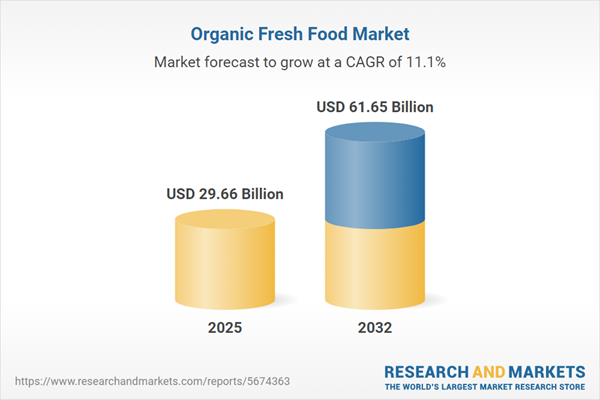Speak directly to the analyst to clarify any post sales queries you may have.
The organic fresh food market is undergoing significant transformation as senior leaders respond to evolving transparency standards, regulatory shifts, and new consumer priorities. Strategic adaptation is critical for maintaining operational resilience and building competitive advantage in today’s dynamic marketplace.
Market Snapshot: Organic Fresh Food Market
The organic fresh food market continues to grow at a steady pace, expanding from USD 26.65 billion in 2024 to USD 29.66 billion in 2025, supported by a CAGR of 11.05%. Forward-looking projections indicate the market is set to reach a value of USD 61.65 billion by 2032.
Increased demand for ethically sourced offerings, broader expectations around supply chain transparency, and rising participation in digital commerce are powering this momentum. Investments in advanced technology are streamlining operations and reinforcing regulatory compliance, while also equipping organizations to withstand shifting policies and constantly changing business pressures.Scope & Segmentation of the Organic Fresh Food Market
- Product Types: Dairy, fruits, vegetables, meat and poultry, seafood, herbs, and spices—these product categories enable suppliers and manufacturers to address a broad range of B2B client preferences while facilitating innovative purchasing strategies and new product development.
- Distribution Channels: Channels such as convenience stores, grocery chains, hypermarkets, online platforms, and specialty retailers provide greater market access and procurement efficiency for business buyers, supporting seamless bulk ordering and reliable logistics networks.
- End Users: Food processors, foodservice providers, bakeries, beverage manufacturers, dairy producers, and individual consumers all integrate organic fresh foods into their operations to meet internal sustainability goals, enhance differentiation, and align with rising industry benchmarks.
- Organic Certifications: Certification schemes like EU Organic, USDA Organic, and JAS play a pivotal role in ensuring consistent quality, facilitating compliance across international markets, and simplifying cross-border transactions for globally active enterprises.
- Regional Coverage: Coverage spans the Americas, Europe, Middle East, Africa, and Asia-Pacific—each region offers a unique mix of opportunity and regulatory complexity, with key contributions from the United States, Germany, China, and Australia further driving growth and investment.
- Key Companies: Market leaders such as Greenyard NV, Dole Food Company, Fresh Del Monte Produce, Taylor Farms, Bonduelle S.A., Grimmway Farms, Mann Packing Co., Driscoll's, Naturipe Farms, and Earthbound Farm LLC leverage innovation in agriculture and automation to accelerate sector progress and operational transformation.
Key Takeaways for Senior Decision-Makers
- Greater transparency along the supply chain builds corporate credibility and nurtures reliable B2B relationships across the organic fresh food sector.
- The introduction of artificial intelligence, Internet of Things, and blockchain technology enables real-time visibility for tracking, monitoring, and ensuring traceability of goods—supporting modern procurement and addressing evolving business expectations.
- Staying informed about changing regulatory frameworks and actively managing certification processes helps mitigate risks and supports quality standards.
- Close collaboration with regional growers, as well as the use of greenhouse-grown produce, allows organizations to maintain consistent and flexible sourcing options despite market uncertainty.
- Deploying targeted market intelligence and developing unified brand strategies enables businesses to identify and reach priority segments for sustained performance in a competitive environment.
Tariff Impact: Adapting to Shifting Policy Environments
Recent revisions in U.S. agricultural tariffs are compelling organizations to adjust their sourcing and distribution plans. Businesses are turning to closer collaboration with local partners and greenhouse producers to reinforce supply stability. Emphasizing domestic sourcing and strengthening supplier relationships are effective strategies to minimize exposure to cost volatility and potential disruptions caused by evolving policy landscapes.
Methodology & Data Sources
This study is based on a combination of quantitative executive interviews, structured surveys across key market participants, and a thorough evaluation of relevant industry literature. Each data point is validated through a stringent protocol, ensuring all findings are reliable and support actionable insights for informed decision-making.
Why This Report Matters: Organic Fresh Food Market
- Offers leaders clear direction for aligning operational strategies with the latest regulatory guidance, empowering flexible decision-making amid rapid change.
- Supports the informed use of digital and automation technologies to stabilize supply chains, enhance compliance, and streamline management processes.
- Delivers actionable recommendations for building robust logistics and sourcing frameworks, helping organizations maintain continuity as the market evolves.
Conclusion
Executive teams can leverage this analysis to address regulatory challenges, strengthen business operations, and drive sustainable success in the advancing organic fresh food market.
Additional Product Information:
- Purchase of this report includes 1 year online access with quarterly updates.
- This report can be updated on request. Please contact our Customer Experience team using the Ask a Question widget on our website.
Table of Contents
3. Executive Summary
4. Market Overview
7. Cumulative Impact of Artificial Intelligence 2025
Companies Mentioned
The companies profiled in this Organic Fresh Food market report include:- Greenyard NV
- Dole Food Company, Inc.
- Fresh Del Monte Produce Inc.
- Taylor Farms, Inc.
- Bonduelle S.A.
- Grimmway Farms, Inc.
- Mann Packing Co., Inc.
- Driscoll's, Inc.
- Naturipe Farms, LLC
- Earthbound Farm LLC
Table Information
| Report Attribute | Details |
|---|---|
| No. of Pages | 183 |
| Published | October 2025 |
| Forecast Period | 2025 - 2032 |
| Estimated Market Value ( USD | $ 29.66 Billion |
| Forecasted Market Value ( USD | $ 61.65 Billion |
| Compound Annual Growth Rate | 11.0% |
| Regions Covered | Global |
| No. of Companies Mentioned | 11 |









